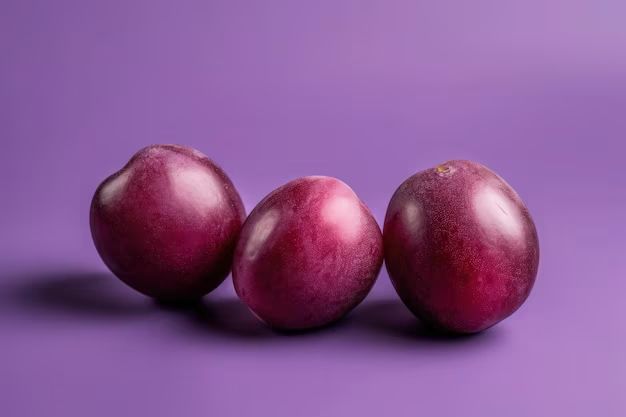The color of plums can vary quite a bit from variety to variety. While some plums may appear more reddish-purple, others can look decidedly burgundy. So which color category do plums fall into – burgundy or purple? Let’s take a closer look at the science behind plum color.
The Color Spectrum
To understand whether plums are burgundy or purple, we first need to understand how color is categorized. The visible color spectrum can be divided into 7 main hues: red, orange, yellow, green, blue, indigo, violet. Burgundy is a tone of red, while purple is mixture of red and blue.
The color wheel shows how colors relate to each other. Burgundy sits between red and purple on the color wheel. So while burgundy contains hints of purple, it is still considered a shade of red rather than true purple.
| Color | Wavelength Range |
|---|---|
| Red | 700-635 nm |
| Orange | 635-590 nm |
| Yellow | 590-560 nm |
| Green | 560-490 nm |
| Blue | 490-450 nm |
| Indigo | 450-420 nm |
| Violet | 420-380 nm |
As shown in the table above, colors have specific wavelength ranges within the visible light spectrum. Burgundy falls within the longer red wavelengths while purple is a mix of red and shorter blue/violet wavelengths.
The Pigments in Plum Skin
The rich color of plums comes from natural plant pigments called anthocyanins. There are many types of anthocyanins that produce different shade of red, purple, and blue depending on their chemical structure.
The most common anthocyanins found in plums are cyanidin-3-glucoside and cyanidin-3-rutinoside. These impart a more reddish-purple color, ranging from red to reddish-blue. Other pigments like peonidin-3-glucoside add to the red tones in plums.
Compared to grapes, plums contain a higher proportion of cyanidin pigments versus delphinidin pigments. Since delphinidin provides a bluer shade, this makes plums skews toward the redder end of the spectrum.
Factors Affecting Plum Color
Several factors impact the final color that develops on plum skin:
- Plum variety – Different cultivars produce different levels of pigments.
- Maturity – Unripe plums tend to be more greenish while fully ripe plums develop a deeper, richer tone.
- Growing conditions – Sun exposure, soil nutrition, weather patterns can affect pigment production.
- Processing method – Drying and curing methods alter appearance.
For example, Black Beaut and Burgundy plums are very dark, almost blackish-red when ripe. Meanwhile, Santa Rosa and Elephant Heart plums remain reddish-purple. Dried prunes become extremely dark brownish-purple as moisture evaporates.
Measuring Plum Color
Researchers use lab techniques like spectrophotometry and chromametry to analyze the color properties of plums. These methods measure the wavelengths of light reflected from the fruit skin to characterize color numerically.
By determining hue angle, chroma, lightness, and percentages of redness, research has confirmed that most plums fall in a reddish-purple range rather than a true purple. Specifically, plum hues tend to span between 320° to 350° on the color wheel with moderate chroma and lightness.
However, there are some Japanese and American hybrid plum varieties that can reach into the blue-purple spectrum, with lower hue angles of 280° to 320°. Additionally, a few unique plums actually fall more into a true purple classification, like the Prunus salicina ‘Amethyst’ plum cultivar.
Plum Color Terms
Given the diversity of plum shades, several descriptive terms are used by growers and consumers when referring to plum color:
- Red – Plums ranging from bright red to deep red
- Dark red – Very deep, vivid red plums
- Purple – General category for red-blue plums, from reddish-purple to bluish-purple
- Blue – Rare bluish-purple plums
- Black – Extremely dark plums, not literally black
- Green – Unripe plums that are still greenish
- Yellow – Special yellow-fleshed plums
- Orange – Unique orange plum varieties
These descriptors provide a general sense of the plum’s color characteristics. But most plums fall somewhere between red, reddish-purple, and purple. True purple plums are less common while orange and yellow plums are rare.
Typical Plum Color Distribution
Analyzing several scientific studies that measured color properties of various plum varieties shows some overall trends:
- About 25% of plums are red-purple (hue angle 320°-350°).
- Around 60% are reddish-purple (hue angle 350°-20°).
- Only 10% are purple (hue angle 280°-320°).
- 5% or less exhibit blue-purple hues (angle less than 280°).
So in summary, the majority of plums display a distinctly reddish-purple color, skewing more towards red than true purple. A small percentage demonstrate a more pure purple shade. True blue-purple plums are exceptionally uncommon.
Conclusion
While the color of plums can range from red to purple, most varieties exhibit a distinctly reddish-purple hue. This is due to the types of anthocyanin pigments they contain. Only a small fraction of plums fall into a pure purple category based on their color wavelengths and visual characteristics. So in general, plums are better described as reddish-purple rather than true purple or burgundy. The rich diversity of plum shades provides a rainbow of color options to enjoy.

